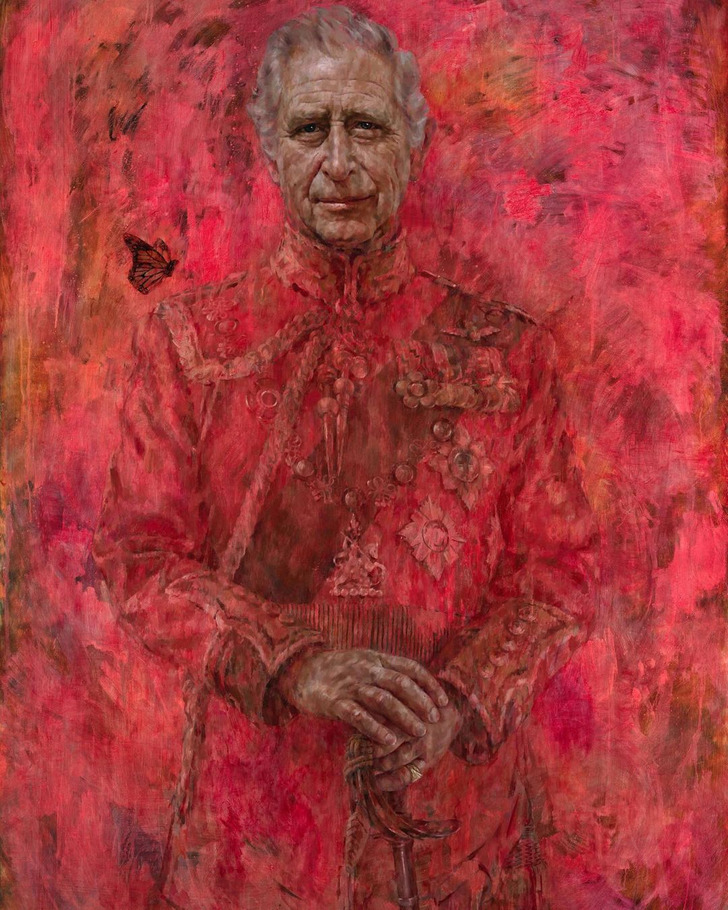In a dramatic unveiling that has left the public and critics buzzing, King Charles III revealed his first official portrait since ascending to the throne, and reactions have been anything but tepid. As debates rage on social media and in art circles, it is clear that King Charles’ portrait is destined to be one of the most talked-about royal artworks in recent history.
The unveiling

Recently, King Charles III personally unveiled a new portrait of himself at Buckingham Palace, the first such portrait since his coronation. The Royal Family’s Instagram account shared an exclusive video of the unveiling, featuring the king himself presenting the artwork.
This significant new work will ultimately be displayed in Drapers’ Hall in London, adding to its historical art collection and offering the public a glimpse of the monarch’s regal presence.
There was an ongoing debate in the comments.

The unveiling sparked a heated debate in the comments section on the Royal Family’s Instagram post and other social media sites. Opinions were sharply divided, with some users harshly criticizing the artwork. Comments ranged from “That is hideous” and “Without sounding rude, this is the worst royal portrait I’ve ever seen” to “100% thought this was satire.”
One critic remarked, “The face is good, the rest is appalling,” while another noted, “I would have loved this if it was any other color than red. He really captured the essence of him in the face, but the harshness of the red doesn’t match the softness of his expression.”
Despite the criticism, there were also voices of appreciation, such as “A lovely portrait of King Charles! I love the way the muted background draws attention to his face!” The mixed reactions highlight the polarizing nature of the portrait and the strong emotions it has evoked among the public.
The artist
Jonathan Yeo, a prominent figure in the world of figurative painting, has earned widespread acclaim for his unique blend of traditional and experimental portraiture. Yeo’s distinctive approach involves a deep engagement with his subjects, allowing him to capture their essence beyond mere physical appearance.
His recent portrait of King Charles III epitomizes this philosophy. Yeo explained, “As a portrait artist, you get this unique opportunity to spend time with and get to know a subject, so I wanted to minimize the visual distractions and allow people to connect with the human being underneath.”
The meaning of the portrait.
A particularly striking element of Yeo’s portrait is the inclusion of a butterfly. This detail serves multiple purposes, both symbolic and compositional. Yeo elaborated, “Primarily a symbol of the beauty and precariousness of nature, it highlights the environmental causes the King has championed most of his life and certainly long before they became a mainstream conversation.”
The butterfly also provides a visual contrast to the uniform, softening the portrayal and adding layers of meaning. “In the context of art history, a butterfly often symbolizes metamorphosis and rebirth, paralleling the King’s transition from Prince to monarch during the period the portrait was created,” Yeo noted, further emphasizing the transformative phase in King Charles’s life.

Yeo expressed his gratitude and honor for being commissioned to create such a significant portrait. “It was a privilege and pleasure to have been commissioned by The Drapers’ Company to paint this portrait of His Majesty The King, the first to be unveiled since his Coronation.”
Yeo’s approach to portraiture aims to encapsulate the life experiences and humanity etched into his subjects’ faces. “I do my best to capture the life experiences and humanity etched into any individual sitter’s face, and I hope that is what I have achieved in this portrait,” he explained.
The challenge of portraying a figure as complex and significant as King Charles III was substantial, but one that Yeo found immensely rewarding. “To try and capture that for His Majesty The King, who occupies such a unique role, was both a tremendous professional challenge, and one which I thoroughly enjoyed and am immensely grateful for,” he concluded. The portrait, destined for Drapers’ Hall in London, stands as a testament to both the artist’s skill and the monarch’s enduring legacy.
Discover the lesser-known facets of King Charles III’s life in our compelling article, “8 Things About King Charles III That Will Allow Us to Know Him More Closely.” Dive beyond the regal exterior to uncover intimate details about his passions, personal experiences, and unique quirks.
Preview photo credit Kin Cheung / Associated Press / East News, theroyalfamily / Instagram, jonathanyeo / Instagram
Pauley Perrette’s life has completely changed since she left NCIS. All prayers are with her.

Pauley Perrette disclosed that in 2021 she had experienced a stroke.
Fans were initially critical of her new hairstyle after she dyed it, but by 2023, most of them appeared to have changed their minds.
Perrette departed from “NCIS” due to a well-known co-star’s actions.
Pauley Perrette talked about a health issue she had on September 2, 2021 in a social media video that she posted in September 2022. The actress disclosed that it was the first anniversary of her severe stroke.
The celebrity talked on how difficult that time had been for her, as she had lost close ones and friends. Perrette expressed her gratitude and faith-filledness, referring to herself as a survivor for having overcome her experiences.

The famous person talked about how she had avoided death multiple times after suffering from potentially fatal food and hair color sensitivities. She has also overcome domestic abuse, sexual assault, and an almost fatal attack by a deranged homeless person. After two years of suffering, Perrette felt “good” about herself and her rescue pets.

Her appearance has evolved since she left her most well-known position on “NCIS” as forensic specialist Abby Sciuto. Fans first reacted negatively to the actress’s new appearance, but some of them have subsequently softened. The year before she disclosed her stroke, Perrette flaunted her rainbow-colored hair.
After quitting “NCIS,” how did Pauley look like, and what reaction did her fans have?
Perrette shared a number of pictures of herself on Twitter on November 10, 2021, showing off a new appearance. The celebrity said she looked like a “rainbow” after dyeing her hair, and the pictures showed her hair tousled and damp.
One troll remarked the actress’s hair was “ugly” before declaring they weren’t sorry for their remarks. The individual said Perrette “looked cheap” with her new appearance, despite having “such a beautiful face.” The commentator pointed out that Perrette’s appearance was limited to Walmart patrons.


The reviewer expressed their admiration for colorful hair but thought the celebrities’ hair was “ratty.” She was criticized by someone else who stated her appearance was “horrible,” and someone else said it was “awful.”
But, it appeared that after Perrette disclosed that she had experienced a stroke and other hardships in life, people’s opinions had changed. The famous person uploaded multiple photos to Instagram on July 24, 2023. The first photograph featured her looking amazing with rainbow-colored hair.
Perrette declared that she is “terrified of Harmon” and that she fears an attack from him.
In response, someone told her to “keep on being you” since she was “awesome.” Another admirer dubbed her “Aunt P” said the actress was “so beautiful” and professed their love for her, while still another remarked on how well she could make others smile.
The admirer believed that Perrette was content in the remaining photos and advised her to “stay you,” be happy, and keep safe.
After working on “NCIS” for 15 years, Perrette left the show in 2018. According to a number of sources, the actress quit the show in 2016 due to a reported falling out with her co-star Mark Harmon. The two were reportedly having problems behind the scenes.

According to reports, Harmon brought his dog to the scene that year, and it bit a crew worker, requiring fifteen stitches. The fact that they never shared a screen shot during the actress’s farewell episode served as evidence of their falling out.
When Perrette visited the “NCIS” headquarters to bid her coworkers farewell, her co-star’s character only got a letter that he read as she was observing him from the other side of the street.
She declared in a 2019 Twitter post that she would never change her part in the show. Perrette declared that she was “terrified of Harmon” and that she feared an attack from him. The actress claimed that she was having nightmares about the potential catastrophe and that she had moved on to a new, pleasant program that was safe.



Leave a Reply